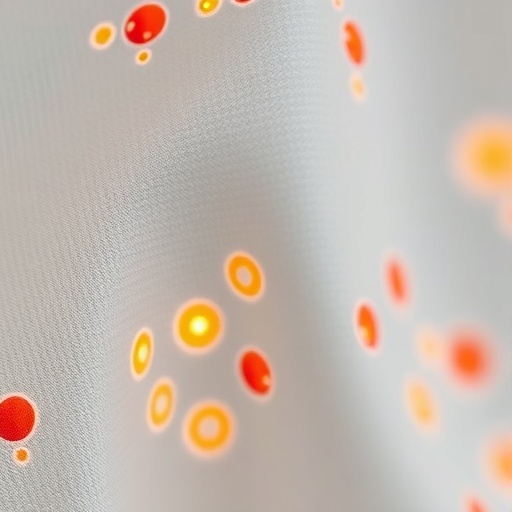In the quest for continuous and non-invasive health monitoring, sweat analysis has emerged as a particularly promising frontier. Recent advancements have shifted the focus from rigid devices to flexible, wearable technologies that can seamlessly integrate with everyday life. Among these innovations, the development of vertical textile microfluidics stands out as a transformative breakthrough, propelling the field of on-garment biosensing into uncharted territory. A team led by Galliani, Ismailova, Azizian, and colleagues has unveiled a pioneering approach to sweat sampling that leverages vertically engineered microfluidic channels embedded directly within textile fibers, enabling unprecedented real-time, on-garment biosensing capabilities.
The heart of this technology lies in its novel microfluidic architecture, which diverges sharply from traditional planar designs common in wearable sensors. Instead of relying on horizontal channels etched onto flexible substrates, vertical textile microfluidics utilize the three-dimensionality of textile weave structures to channel sweat directly from the skin surface into the sensor interface. This vertical integration harnesses capillarity and gravitational forces in tandem, thereby optimizing sweat collection efficiency even under minimal perspiration conditions. Such capability is critical for continuous monitoring during daily activities where sweat rates are typically low.
In practical terms, this fabric-based microfluidic network consists of vertically aligned channels that penetrate through the multiple layers of the garment itself. These channels guide sweat through tightly controlled micro-environments before it reaches embedded biosensors that perform real-time chemical and biochemical analyses. The textile modality ensures comfort and durability, while the vertical channel orientation mitigates issues of sweat pooling and evaporation, which have historically hampered the reliability and accuracy of wearable sweat sensors.
Crucially, the integration of vertical microfluidic channels within textiles does not compromise the mechanical properties of the clothing. The textile retains its breathability, flexibility, and softness, addressing a significant hurdle in wearable technology adoption: user comfort. By preserving the tactile qualities of everyday garments, this innovation facilitates not only physiological data collection but also user adherence, which is essential for gathering meaningful longitudinal health data.
From a biochemical perspective, the microfluidic channels facilitate the targeted capture and transport of sweat to the sensor region while minimizing sample dilution and contamination. This precision sampling is vital for accurate quantification of key analytes such as electrolytes, metabolites, and hormones that reflect an individual’s hydration status, metabolic state, stress levels, and even onset of disease. The researchers’ vertical microfluidic design ensures that sweat samples remain uncontaminated by environmental factors while maintaining the biological integrity of the biomarkers.
One remarkable aspect of this system is its ability to support real-time biosensing through seamless integration with electrochemical sensors embedded within the textile layers. These sensors detect multiple biomarkers simultaneously, providing a multi-parametric health snapshot. This multiplexed capability is a substantial leap from single-analyte sweat sensors previously limited by planar architectures and insufficient fluid handling. The system’s continuous data stream offers invaluable insight into dynamically changing physiological conditions, opening pathways for personalized healthcare interventions.
The fabrication of vertical textile microfluidic devices involves advanced textile engineering combined with microfabrication techniques. The researchers employed precision weaving and fiber functionalization to construct the vertical channels, followed by deposition of biocompatible conductive materials to establish sensor electrodes. These manufacturing processes are scalable and compatible with standard textile production lines, suggesting that mass-market adoption is viable without prohibitive costs or complex post-processing.
Moreover, the sensing platform demonstrates remarkable robustness in varying environmental conditions, including fluctuations in temperature and humidity—factors that often plague sweat-based biosensors. The vertical channel architecture ensures consistent sweat sampling under sweat evaporation rates typical during daily activity, as well as during more strenuous physical exertion. This versatility significantly enhances the practical application spectrum of wearable sweat monitoring, ranging from fitness tracking to clinical health surveillance.
Data analytics integrated with the textile biosensing platform further amplifies its impact. Customized algorithms filter noise, calibrate sensor drift, and interpret complex biomarker patterns in real-time, delivering actionable insights via wireless communication to smartphones or cloud platforms. This tight coupling of hardware and software creates a closed-loop system that could revolutionize chronic disease management by enabling proactive rather than reactive healthcare strategies.
In essence, vertical textile microfluidics heralds a new era where clothing transcends its passive role and becomes an active interface for biochemical interrogation. This paradigm shift not only elevates wearable health monitoring but also aligns with the ongoing trends toward minimally invasive diagnostics and personalized medicine. The seamless integration of microfluidics into everyday garments promises to democratize access to continuous health data, empowering users with timely knowledge about their physiological status.
Looking ahead, further refinements in sensor sensitivity, selectivity, and multiplexing may broaden the range of detectable biomarkers, encompassing not just sweat constituents but potentially other bodily fluids through transdermal sampling. This could expand the utility of vertical textile microfluidic platforms beyond health and fitness into fields like environmental exposure monitoring and occupational safety.
Additionally, interdisciplinary collaboration involving materials science, biomedical engineering, data science, and fashion design will be crucial to optimize ergonomic factors, aesthetic appeal, and sensor performance. Such holistic development will ensure these innovative textiles are not only technologically advanced but also desirable and convenient for daily wear.
In conclusion, the advent of vertical textile microfluidics represents a pivotal technological intersection where textile engineering melds with microfluidic science and biosensing to transform garments into sophisticated health-monitoring devices. Galliani, Ismailova, Azizian, and their team’s work embodies a formidable step forward in wearable technology, delivering a platform that blends function, form, and user experience with unprecedented efficacy.
As wearable health technology races forward, vertical textile microfluidics offers a viable, scalable, and compelling solution that could fundamentally reshape how individuals engage with their health. By converting everyday clothing into a continuous window into biochemical landscapes, this innovation paves the way for a future where personalized health insights are effortlessly woven into the fabric of life itself.
Subject of Research:
Article Title:
Article References:
Galliani, M., Ismailova, E., Azizian, P. et al. Vertical textile microfluidics: advancing on-garment sweat sampling for real-time biosensing. npj Flex Electron 9, 38 (2025). https://doi.org/10.1038/s41528-025-00416-5
Image Credits: AI Generated




